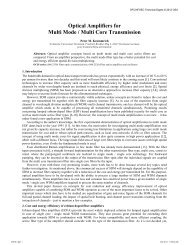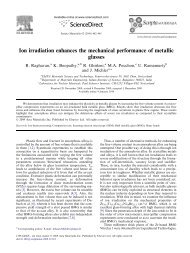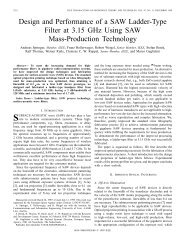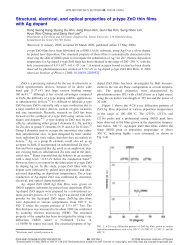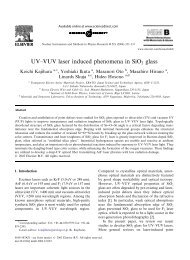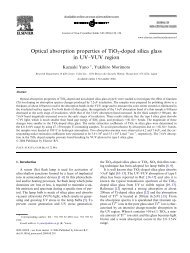Passively Q-switched nanosecond pulse-train Nd:YAG laser system
Passively Q-switched nanosecond pulse-train Nd:YAG laser system
Passively Q-switched nanosecond pulse-train Nd:YAG laser system
Create successful ePaper yourself
Turn your PDF publications into a flip-book with our unique Google optimized e-Paper software.
In our experiment number of <strong>laser</strong> <strong>pulse</strong>s in the <strong>laser</strong> <strong>pulse</strong> <strong>train</strong> was controlled by changing of the oscillator flashlamp<br />
pumping energy for 1 ms duration of the flashlamp <strong>pulse</strong> to matched with lifetime of the gas puff target. The number of<br />
<strong>laser</strong> <strong>pulse</strong>s as a function of flashlamp pumping energy is shown in Fig. 5.<br />
Q)Cl)<br />
• E<br />
0,4<br />
0,2<br />
0,0<br />
200<br />
400<br />
600<br />
800<br />
1000<br />
Fig. 5. Laser <strong>pulse</strong> <strong>train</strong>s as a function of oscillator pumping energy.<br />
The <strong>laser</strong> <strong>pulse</strong>s creating <strong>train</strong>s shown in Fig. 5 have equal energy and duration (FWHM). Laser <strong>pulse</strong> <strong>train</strong> energy vs.<br />
number of <strong>laser</strong> <strong>pulse</strong>s is shown in Fig. 6.<br />
30<br />
25<br />
20<br />
E 15<br />
a)<br />
w 10<br />
2 4 6 8 10<br />
15<br />
Number of <strong>pulse</strong>s<br />
Fig. 6. Energy ofthe <strong>laser</strong> <strong>pulse</strong> <strong>train</strong> vs. number of <strong>pulse</strong>s.<br />
Low intensity <strong>laser</strong> <strong>pulse</strong>s from the oscillator should be amplified to obtain intensity required for effective EUV and soft<br />
X-ray production (101 1.4013 W/cm2). Assuming 100 tm diameter of the focus we should have 100 mJ of energy for 1 3 ns<br />
<strong>laser</strong> <strong>pulse</strong> to reach power density of lOl 1W/cm2 after focusing of the <strong>laser</strong> beam. To obtain a flat envelope of the<br />
amplified <strong>laser</strong> <strong>pulse</strong> <strong>train</strong> the energy of a single <strong>laser</strong> <strong>pulse</strong> should be chosen in such a way, that depletion of the<br />
inversion caused by the passage of the one <strong>pulse</strong> will be equal to the production of the inversion between two <strong>pulse</strong>s.<br />
Then the inversion will be constant during a <strong>pulse</strong> <strong>train</strong> and each <strong>pulse</strong> will experience the same gain. For fixed oscillator<br />
20<br />
25<br />
30<br />
35<br />
Proc. of SPIE Vol. 5707 351





